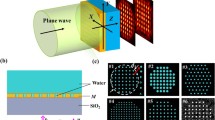Abstract
Considering the nanofabrication errors, the real fabricated metallic nanowires may have irregular cross-sectional shapes. In this work, the metallic nanowires array with arbitrary cross-sectional shapes for negative refraction in visible regime was studied theoretically. To fully understand the evolution process of the negative refraction of the metallic wires with irregular cross-sectional shapes, the effective refractive index, effective mass, and effective radius of the wires were put forth and studied. The nanowire array with arbitrary cross-sectional shapes with different geometrical parameters was investigated in detail by means of computational numerical calculation on the basis of finite difference and time–domain algorithm. The influence of geometrical parameters of the nanowires on negative refraction was systematically analyzed. The calculated results indicate that the irregular shape can play a positive role for the negative refraction-based imaging application.








Similar content being viewed by others
References
LI Mandelshtam (1944) Lectures on some problems of the theory of oscillations. In: Complete collection of works, vol 5. Moscow: Academy of Sciences. pp 428–467
Malyuzhinets GD (1951) A note on the radiation principle. Sov Phys Tech Phys 21:940–942
Veselago VG (1968) The electrodynamics of substances with simultaneously negative values of epsilon and mu. Sov Phys Uspekhi 10:509–514
Notomi M (2000) Theory of light propagation in strongly modulated photonic crystals: Refractionlike behavior in the vicinity of the photonic band gap. Phys Rev B 62:10696–10705
Smith DR, Padilla W, Vier DC, Nemat-Nasser SC, Schultz S (2000) Composite medium with simultaneously negative permeability and permittivity. Phys Rev Lett 84:4184–4190
Shelby RA, Smith DR, Schultz S (2001) Experimental verification of a negative index of refraction. Science 292:77–78
Luo C, Johnson SG, Joannopoulos JD, Pendry JB (2002) Subwavelength imaging in photonic crystals. Phys Rev B 65:201104
Pendry JB, Holden AJ, Stewart WJ, Youngs I (1996) Extremely low frequency plasmons in metallic mesostructures. Phys Rev Lett 76:4773–4776
Pendry JB, Holden AJ, Robbins DJ, Stewart WJ (1998) Low frequency plasmons in thin line structures. J Phys Condens Matter 10:4785–4788
Eleftheriades GV, Iyer AK (2002) Planar negative refractive index media using periodically L–C loaded transmission lines. IEEE Trans Microw Theory Tech 50:2702–2712
Grbic A, Eleftheriades GV (2003) Growing evanescent waves in negative-refractive-index transmission-line media. Appl Phys Lett 82:1815–1817
Grbic A, Eleftheriades GV (2005) Practical limitations of subwavelength resolution using negative-refractive-index transmission-line lenses. IEEE Trans Ant Prop 53:3201–3209
Simth DR, Padilla WJ, Vier DC (2000) A composite medium with simultaneously negative permeability and permittivity. Pys Rev Lett 84:4184–4187
Shelby RA, Simth DR, Schultz S (2001) Experimental variation of a negative index of refraction. Science 292:77–79
Belyantsev AM, Kozyrev AB (2002) Reversed Doppler effect under reflection from a shock electromagnetic wave. Tech Phys 47:1477–1481
Yao J, Liu Z, Liu Y, Wang Y, Sun C, Bartal G, Stacy AM, Zhang X (2008) Optical negative refraction in bulk metamaterials of nanowires. Science 321:930
Liu L (2009) Design and application of index-near-zero metamaterials in microwave band. Master thesis, Chinese Academy of Sciences
Yongqi Fu, Edt (2009) Subwavelength optics: theory and technology. Bentham Science: Oak Park, IL. http://www.benthamscience.com/ebooks/9781608050505/index.htm
FDTD Solution. Professional commercial software from Lumerical Solution Inc. in Canada. http://www.lumerical.com
Wangberg R, Elser J, Narimanov EE, Podolskiy VA (2006) Nonmagnetic nanocomposites for optical and infrared negative-refractive-index media. J Opt Soc Am B 23:493–505
Silveirinha MG, Belov PA, Simovski CR (2007) Subwavelength imaging at infrared frequencies using an array of metallic nanorods. Phys Rev B 75:035108
Acknowledgments
The research work was financially supported by National Natural Science Foundation of China (no. 11079014 and 61077010).
Author information
Authors and Affiliations
Corresponding authors
Rights and permissions
About this article
Cite this article
He, Y., Fu, Y. & Yu, W. Study of Metallic Nanowires with Arbitrary Cross-Sectional Shapes for Negative Refraction in Visible Regime. Plasmonics 7, 619–626 (2012). https://doi.org/10.1007/s11468-012-9350-8
Received:
Accepted:
Published:
Issue Date:
DOI: https://doi.org/10.1007/s11468-012-9350-8




